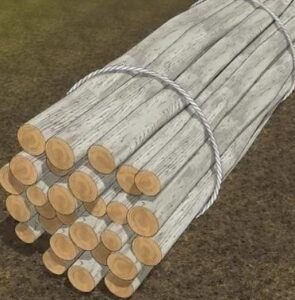You will probably agree that wood is essential for our survival given that, in ancient times people relied on wood for warmth, weapons, and practically everything else. In our modern homes, you will still find wood everywhere that is in your furniture like beds, coffee tables, and closets. However, though a renewable resource, disposing of wood is not as straightforward as pilling and waiting for pick up. This article will guide you on how to dispose of wood.
How to dispose of wood from different types?

Though straight from nature, all wood is 100% recyclable. Once wood reaches the factory, it undergoes various processes that result in different types of wood with varying disposal methods, forming this article’s basis.
Generally, you dispose of through:
1. Disposing the wood at a wood processing facility
This method works best for organizations or individuals with large amounts of wood requiring disposal. Instead of sending the wood to landfills, you can take them to wood processing facilities and at a cost get the wood disposal taken off your hands. In some instances, you can get the wood disposed of without charge if it is clean.
2. Reusing the wood
At times, instead of entirely disposing of your wood, you can try reusing them. Wood you use in fencing you can reuse in landscaping and so on. Look into which reusing options you have. If you lack any and the wood is still in relatively good condition, you can try donating them off to high schools for their wood shops.
3. Recycling the wood
If the earlier two fails, consider recycling the wood into other different forms.
- Mulch to control weeds in farms.
- Sawdust for animal beddings.
- Composite to enhance the soil.
- Wood flour for use spillage cleans up.
- Wood chips for trail stabilization or landscaping.
- Fuel pellets for use in wood stoves.

4. Converting the wood to an energy source
If recycling is not feasible, you need to consider sending the wood to biomass to energy producer who will use the wood to produce steam or electricity.
5. Disposing of the wood through landfills

If the earlier options fail, send the wood to a landfill. However, always ensure this is your last option as it is expensive and not environmentally friendly while dealing with toxic wood. However, you may find your hands tied at times when it comes to wood disposal, as below:
5.1. Treated wood
You can tell if you have treated wood by looking at the color. If it is green in color, it has undergone treatment. Moreover, if it has symmetric hole patterns, you can tell those are injection points. Therefore, the wood has undergone treatment.
Wood generally undergoes treatment to prevent termites and other insects from eating through them. However, this results in the wood becoming toxic and unsuitable for recycling into mulch and sawdust for animal beddings.
As such, you will best dispose of this wood by reserving space in a landfill since energy conversion will also result in toxic fumes.
5.2. Stained wood
Stained wood refers to wood that is not in original color. Provided the wood is not treated, you can break it into smaller pieces and send them for recycling.
5.3. Plywood
Plywood refers to wood that is as strong as lumber yet is made from pieces of wood. Even as oriented strand boards, plywood is always 100% recyclable.
5.4. Particleboard
Particleboards have plastic veneers and tend to crumble. Therefore, particle boards have limited reuse options. However, reuse is the best disposal method.
5.5. Wood with metal pieces
While considering wood disposal, always ensure you check on the sizes of metals like nails in the wood.
If the metals are more significant than a doorknob, ensure you remove them as recycling plants will not accept them as they can become lethal projectiles during recycling. However, small pieces are safe as they will be crushed by the machines then picked off by powerful magnets.
5.6. Palm fronds
Palm fronds, ivy, yucca, and the likes are not feasible for recycling owing to their wrapping around grinders. Therefore, try reusing them or sending them to biomass to energy producers.
What not to do when disposing of wood?

1. Do not burn treated wood because the smoke and ash will contain toxic chemicals.
2. When dealing with fresh wood, avoid disposing of it far away as it may have parasites or diseases that might thrive there and pose a risk to the trees.
3. Do not dispose of wood through bonfires if your local government does not allow such.
4. Do not leave wood that is to be disposed of out in the streets for long awaiting pick up. Tie them neatly, leave them in your compound, and only bring them out the night before trash collection.
5. Do not forget to remove metal pieces more significant than your doorknob to protect workers at recycling plants from harm.
6. Never break the wood into tiny pieces; put them into your small trash bag haphazardly, and leave it open. Always contact the trash disposal company when the wood is a lot and make arrangements for their collection.
7. Do not recycle treated timber into animal bedding.
FAQs
1. Can I put wood in the recycle bin?
No, recycle streams are meant to be residue-free, clean, and composed of recycling curbside items like glass, paper, plastic. Ensure you dispose of wood in the earlier stated manners.
2. Is pressure-treated wood recyclable?
Yes, though some manufacturers assure you pressure treated timber will resist decay for up to 40 years, pressure-treated wood is safe for recycling and reuse. However, during recycling toxicity of chemicals used in these types of wood have to be considered.
Conclusion
When it comes to wood disposal, follow the guidelines above to ensure you tackle the issue appropriately. Moreover, always ensure you look upon your local area’s wood disposal procedures to ensure you do not find yourself on the wrong side of the law. All in all, wood is an aspect of our daily lives. Therefore, we should dispose of it most appropriately, putting sustainable forestry and conservation always being forethought.
Disposing of old things is quite an intractable problem. You may be interested in:
How to dispose of cooking oil?
